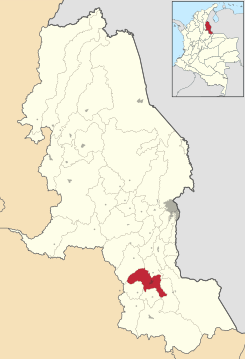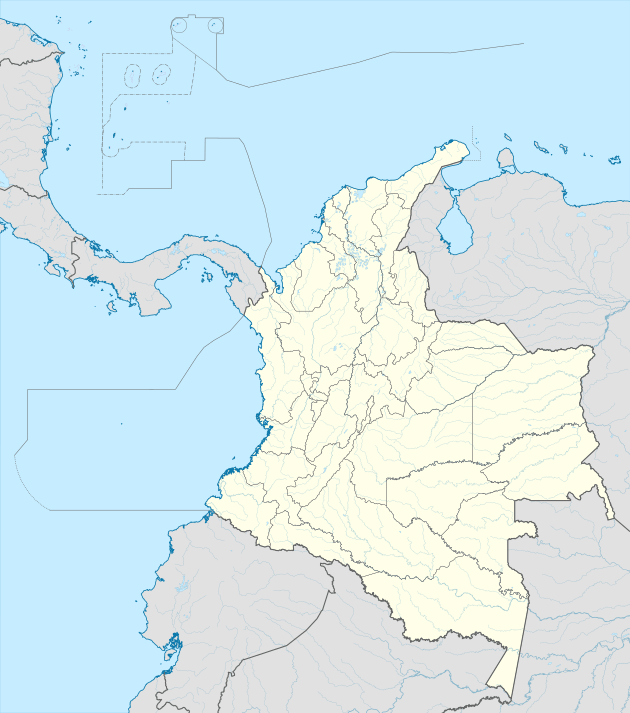Pamplona, Norte de Santander
Pamplona (pronounced [pamˈplona]) is a municipality and city in Norte de Santander, Colombia.
Pamplona | |
|---|---|
Pamplona | |
.svg.png) Flag .svg.png) Seal | |
| Nickname(s): Student City, Miter City, Holy Spirit Valley | |
 Location of the municipality and town of Pamplona, Colombia in the Norte de Santander Department of Colombia. | |
 Pamplona Location in Colombia | |
| Coordinates: 07°22′41″N 72°39′09″W | |
| Country | |
| Department | North of Santander |
| Founded | 1549 |
| Government | |
| • Mayor | Carlos Arturo Bustos Cortés |
| Area | |
| • Municipality | 318 km2 (123 sq mi) |
| Elevation | 2,342 m (8,485 ft) |
| Population (2015) | |
| • Municipality | 57,803 |
| • Density | 180/km2 (470/sq mi) |
| • Urban | 54,894 |
| • Demonym | Pamplonés |
| Time zone | UTC-5 (Colombia Standard Time) |
| Area code(s) | 57 + 7 |
| Website | Official website (in Spanish) |
History
Colonization
The town was founded on 1 November 1549 as Nueva Pamplona del Valle del Espíritu Santo, named after the capital of the Kingdom of Navarre, Crown of Castile, by Pedro de Ursúa and Ortún Velasco de Velázquez. From there they divided the expeditions that founded, among others, the populations of Mérida, San Cristóbal and La Grita, in the Republic of Venezuela, and Ocaña, Salazar de las Palmas, Chinácota, San Faustino, Bucaramanga and Cúcuta in Colombia.
The natives, called Chitareros by the Spanish, were the first inhabitants of the old Province of Pamplona. They were called thus by the Spaniards, because of the general custom that the men had to carry hanging from the waist calabazo or totumo with chicha or maize wine as the Spaniards called it. Asking how the thing they carried was called, the natives responded that it was a chitarero.
When the area was occupied by Pedro de Ursúa and Ortún Velasco in 1549, they reduced the primitive settlers to the regime of encomiendas. Around 100 groups or capitanejos were distributed in 53 encomiendas through all the territory, according to investigator Jaramillo Uribe.
The town's location allowed it to become an important commercial route between the Viceroyalty of New Granada and the Captaincy of Venezuela, with territories of great fertility and auriferous deposits in the mountains, it became one of the richest territories of the colony, only competed by the province of Socorro, which contributed to that outside considered a political and administrative axis of the Spanish crown from the time of the conquest.
Independence
Pamplona earned the nickname of "Patriotic City" as described by Simón Bolivar as pioneering the New Granadan revolution 4 July 1810, in person of Doña Agueda Gallardo de Villamizar (freedom that finally declared 31 July of the same year with a provisional Assembly), and later, between thousands eight hundred nineteen and thousands eight hundred twenty one, by having contributed remarkably with human and economic resources for, without equal, develop liberator of Colombia and Venezuela. Pamplona was as important as Bogotá.
In 1910, with the creation of the Department of Norte de Santander, were included within their political jurisdiction, integrating itself like the Province of Pamplona, that is as well conformed by the municipalities of Cácota de Velasco, Cucutilla, Chitagá, Labateca, Mutiscue, Pamplonita, Toledo and Silos. Culturally it is possible to emphasize an endless number of activities that extends the planes national and international, that make of the Student City a tourist epicenter that is worth the trouble well to share: the Greater Week - than along with the celebrations of Mompox and Popayán they are most important of the country.
The city of Pamplona is in the southwest of the Department, along with the municipalities of Pamplonita, Chitagá, Silos, Cácota and Mutiscua. The urban area by being catalogued like student city with ample impact in university formation stands out on the region, is also identified by the solemnity of its religious celebrations, between which the Easter stands out, event that counts on ample presence of originating people of the hinterlands and of Venezuela. [to publish]
Climate
There are a couple of weather conditions you will encounter there in Pamplona such as cloudy, rainy and sunny.
In average high temperatures of 18 °C (64 °F) - 19 °C (66 °F) and lows of 7 °C (45 °F) - 11 °C (52 °F).
Economy
The agricultural production: Potatoes are the principal product, followed by strawberry, garlic, wheat, morón, maize, beans, and carrots. Livestock: cows, pigs, fishing, rabbits and poultry Commercial activity: food production like candies and collations, garment production, and tourism.
Pamplona is a [student city](https://en.wikipedia.org/wiki/College_town), hosting the University of Pamplona. That and tourism are probably the main present economic activities, where thousands of students are lodged and fed, thus also are the main consumers in innumerable the night clubs and cafés that have been proliferating.
References
External links
| Wikivoyage has a travel guide for Pamplona (Colombia). |